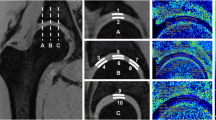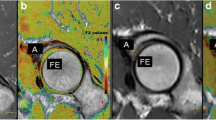Abstract
Background
T1ρ MRI is an imaging technique sensitive to proteoglycan (PG) content of hyaline cartilage. However, normative T1ρ values have not been established for the weightbearing cartilage of the hip, and it is not known whether it is uniform or whether there is topographic variation. Knowledge of the T1ρ profile of hyaline cartilage in the normal hip is important for establishing a baseline against which comparisons can be made to experimental and clinical arthritic subjects.
Questions/purposes
In this diagnostic study, we determined (1) the T1ρ MRI values of hyaline cartilage of the normal hip; and (2) whether the T1ρ MRI profile of the normal hip hyaline cartilage is uniform.
Methods
Fourteen asymptomatic volunteers (11 men, three women; mean age, 35 years) prospectively underwent 1.5-T T1ρ MRI of a single hip. The weightbearing hyaline cartilage bilayer of the acetabulum and femoral head was evaluated on sagittal images and segmented into four zones: (1) anterior; (2) anterosuperior; (3) posterosuperior; and (4) and posterior. For the full region of interest and within each zone and each sagittal slice, we calculated the mean T1ρ relaxation value, a parameter that indirectly quantifies PG content, where T1ρ is inversely related to PG concentration.
Results
There was variation in the T1ρ relaxation values depending on zone (anterior to posterior) and slice (medial to lateral). When combining the most anterior quadrants (Zones 1 and 2), the T1ρ relaxation values were lower than those in the combined posterior quadrants (Zones 3 and 4) (30.4 msec versus 32.2 msec, respectively; p = 0.002), reflecting higher PG concentration. There was a difference between the T1ρ relaxation values of the sagittal slices (p = 0.038), most pronounced anteriorly in Zone 1 (26.6 msec, p = 0.001). With a selective combination of zones and slices, there were lower mean T1ρ values in the anterolateral-most region compared with the remainder of the weightbearing portion of the hip (28.6 msec versus 32.2 msec, respectively; p = 0.001).
Conclusions
The T1ρ profile of normal hyaline cartilage of the hip is not uniform with the topographic differences identified suggesting regional variations in PG concentration. This study, through determination of lower T1ρ relaxation values, suggests inherently greater PG concentrations in the more anterolateral region of the normal hip hyaline cartilage. Furthermore, it demonstrates that T1ρ MRI has the ability to detect even subtle, microscopic local differences in hyaline cartilage composition. This technique has the potential to facilitate basic science and clinical research by serving as a noninvasive surrogate or biomarker of cartilage health and thus may be added to the growing repertoire of advanced, biochemical MRI techniques for evaluating hyaline cartilage.
Level of Evidence
Level III, diagnostic study. See Instructions for Authors for a complete description of levels of evidence.


Similar content being viewed by others
References
Akella SV, Regatte RR, Gougoutas AJ, Borthakur A, Shapiro EM, Kneeland JB, Leigh JS, Reddy R. Proteoglycan-induced changes in T1rho-relaxation of articular cartilage at 4T. Magn Reson Med. 2001;46:419–423.
Beaule PE, Kim YJ, Rakhra KS, Stelzeneder D, Brown TD. New frontiers in cartilage imaging of the hip. Instr Course Lect. 2012;61:253–262.
Beaule PE, Zaragoza E, Copelan N. Magnetic resonance imaging with gadolinium arthrography to assess acetabular cartilage delamination. A report of four cases. J Bone Joint Surg Am. 2004;86:2294–2298.
Bittersohl B, Hosalkar HS, Hughes T, Kim YJ, Werlen S, Siebenrock KA, Mamisch TC. Feasibility of T2* mapping for the evaluation of hip joint cartilage at 1.5T using a three-dimensional (3D), gradient-echo (GRE) sequence: a prospective study. Magn Reson Med. 2009;62:896–901.
Blumenkrantz G, Majumdar S. Quantitative magnetic resonance imaging of articular cartilage in osteoarthritis. Eur Cells Mater. 2007;13:76–86.
Burstein D, Bashir A, Gray ML. MRI techniques in early stages of cartilage disease. Invest Radiol. 2000;35:622–638.
Burstein D, Gray ML. Is MRI fulfilling its promise for molecular imaging of cartilage in arthritis? Osteoarthritis Cartilage. 2006;14:1087–1090.
Carballido-Gamio J, Link TM, Li X, Han ET, Krug R, Ries MD, Majumdar S. Feasibility and reproducibility of relaxometry, morphometric, and geometrical measurements of the hip joint with magnetic resonance imaging at 3T. J Magn Reson Imaging. 2008;28:227–235.
Carter DR, Beaupre GS, Wong M, Smith RL, Andriacchi TP, Schurman DJ. The mechanobiology of articular cartilage development and degeneration. Clin Orthop Relat Res. 2004;427(Suppl):S69–77.
Cunningham T, Jessel R, Zurakowski D, Millis MB, Kim YJ. Delayed gadolinium-enhanced magnetic resonance imaging of cartilage to predict early failure of Bernese periacetabular osteotomy for hip dysplasia. J Bone Joint Surg Am. 2006;88:1540–1548.
Dijkgraaf LC, de Bont LG, Boering G, Liem RS. The structure, biochemistry, and metabolism of osteoarthritic cartilage: a review of the literature. J Oral Maxillofac Surg. 1995;53:1182–1192.
Duvvuri U, Goldberg AD, Kranz JK, Hoang L, Reddy R, Wehrli FW, Wand AJ, Englander SW, Leigh JS. Water magnetic relaxation dispersion in biological systems: the contribution of proton exchange and implications for the noninvasive detection of cartilage degradation. Proc Natl Acad Sci U S A. 2001;98:12479–12484.
Duvvuri U, Kudchodkar S, Reddy R, Leigh JS. T(1rho) relaxation can assess longitudinal proteoglycan loss from articular cartilage in vitro. Osteoarthritis Cartilage. 2002;10:838–844.
Duvvuri U, Reddy R, Patel SD, Kaufman JH, Kneeland JB, Leigh JS. T1rho-relaxation in articular cartilage: effects of enzymatic degradation. Magn Reson Med. 1997;38:863–867.
Gold GE, Burstein D, Dardzinski B, Lang P, Boada F, Mosher T. MRI of articular cartilage in OA: novel pulse sequences and compositional/functional markers. Osteoarthritis Cartilage. 2006;14(Suppl A):A76–86.
Gray ML, Burstein D, Kim YJ, Maroudas A. 2007 Elizabeth Winston Lanier Award Winner. Magnetic resonance imaging of cartilage glycosaminoglycan: basic principles, imaging technique, and clinical applications. J Orthop Res. 2008;26:281–291.
James SL, Ali K, Malara F, Young D, O’Donnell J, Connell DA. MRI findings of femoroacetabular impingement. AJR Am J Roentgenol. 2006;187:1412–1419.
Kassarjian A, Yoon LS, Belzile E, Connolly SA, Millis MB, Palmer WE. Triad of MR arthrographic findings in patients with cam-type femoroacetabular impingement. Radiology. 2005;236:588–592.
Kurrat HJ, Oberlander W. The thickness of the cartilage in the hip joint. J Anat. 1978;126:145–155.
Li X, Pai A, Blumenkrantz G, Carballido-Gamio J, Link T, Ma B, Ries M, Majumdar S. Spatial distribution and relationship of T1rho and T2 relaxation times in knee cartilage with osteoarthritis. Magn Reson Med. 2009;61:1310–1318.
Lohmander LS. Articular cartilage and osteoarthrosis. The role of molecular markers to monitor breakdown, repair and disease. J Anat. 1994;184:477–492.
Mamisch TC, Bittersohl B, Hughes T, Kim YJ, Welsch GH, Dudda M, Siebenrock KA, Werlen S, Trattnig S. Magnetic resonance imaging of the hip at 3 Tesla: clinical value in femoroacetabular impingement of the hip and current concepts. Semin Musculoskelet Radiol. 2008;12:212–222.
Marquart D. An algorithm for least squares estimation of non-linear parameters. Journal of Society of Industrial and Applied Mathematics. 1963;11:431–441.
Mintz DN, Hooper T, Connell D, Buly R, Padgett DE, Potter HG. Magnetic resonance imaging of the hip: detection of labral and chondral abnormalities using noncontrast imaging. Arthroscopy. 2005;21:385–393.
Mosher TJ, Dardzinski BJ. Cartilage MRI T2 relaxation time mapping: overview and applications. Semin Musculoskelet Radiol. 2004;8:355–368.
Mosher TJ, Walker EA, Petscavage-Thomas J, Guermazi A. Osteoarthritis year 2013 in review: imaging. Osteoarthritis Cartilage. 2013;21:1425–1435.
Pollard TC, McNally EG, Wilson DC, Wilson DR, Madler B, Watson M, Gill HS, Carr AJ. Localized cartilage assessment with three-dimensional dGEMRIC in asymptomatic hips with normal morphology and cam deformity. J Bone Joint Surg Am. 2010;92:2557–2569.
Poole AR. An introduction to the pathophysiology of osteoarthritis. Front Biosci. 1999;4:D662–670.
Rakhra KS, Lattanzio PJ, Cardenas-Blanco A, Cameron IG, Beaule PE. Can T1-rho MRI detect acetabular cartilage degeneration in femoroacetabular impingement? A pilot study. J Bone Joint Surg Br. 2012;94:1187–1192.
Recht MP, Goodwin DW, Winalski CS, White LM. MRI of articular cartilage: revisiting current status and future directions. AJR Am J Roentgenol. 2005;185:899–914.
Regatte RR, Akella SV, Borthakur A, Kneeland JB, Reddy R. Proteoglycan depletion-induced changes in transverse relaxation maps of cartilage: comparison of T2 and T1rho. Acad Radiol. 2002;9:1388–1394.
Regatte RR, Akella SV, Borthakur A, Reddy R. Proton spin-lock ratio imaging for quantitation of glycosaminoglycans in articular cartilage. J Magn Reson Imaging. 2003;17:114–121.
Schmid MR, Notzli HP, Zanetti M, Wyss TF, Hodler J. Cartilage lesions in the hip: diagnostic effectiveness of MR arthrography. Radiology. 2003;226:382–386.
Subburaj K, Valentinitsch A, Dillon AB, Joseph GB, Li X, Link TM, Vail TP, Majumdar S. Regional variations in MR relaxation of hip joint cartilage in subjects with and without femoralacetabular impingement. Magn Reson Imaging. 2013;31:1129–1136.
Tiderius CJ, Jessel R, Kim YJ, Burstein D. Hip dGEMRIC in asymptomatic volunteers and patients with early osteoarthritis: the influence of timing after contrast injection. Magn Reson Med. 2007;57:803–805.
Watanabe A, Boesch C, Siebenrock K, Obata T, Anderson SE. T2 mapping of hip articular cartilage in healthy volunteers at 3T: a study of topographic variation. J Magn Reson Imaging. 2007;26:165–171.
Werlen S. Magnetic resonance arthrography of the hip in femoroacetabular impingement. Oper Tech Orthop. 2005;15:191–203.
Wheaton AJ, Dodge GR, Elliott DM, Nicoll SB, Reddy R. Quantification of cartilage biomechanical and biochemical properties via T1rho magnetic resonance imaging. Magn Reson Med. 2005;54:1087–1093.
Williams A, Gillis A, McKenzie C, Po B, Sharma L, Micheli L, McKeon B, Burstein D. Glycosaminoglycan distribution in cartilage as determined by delayed gadolinium-enhanced MRI of cartilage (dGEMRIC): potential clinical applications. AJR Am J Roentgenol. 2004;182:167–172.
Wyler A, Bousson V, Bergot C, Polivka M, Leveque E, Vicaut E, Laredo JD. Hyaline cartilage thickness in radiographically normal cadaveric hips: comparison of spiral CT arthrographic and macroscopic measurements. Radiology. 2007;242:441–449.
Wyler A, Bousson V, Bergot C, Polivka M, Leveque E, Vicaut E, Laredo JD. Comparison of MR-arthrography and CT-arthrography in hyaline cartilage-thickness measurement in radiographically normal cadaver hips with anatomy as gold standard. Osteoarthritis Cartilage. 2009;17:19–25.
Zilkens C, Miese F, Kim YJ, Hosalkar H, Antoch G, Krauspe R, Bittersohl B. Three-dimensional delayed gadolinium-enhanced magnetic resonance imaging of hip joint cartilage at 3T: a prospective controlled study. Eur J Radiol. 2012;81:3420–3425.
Acknowledgments
We thank Gillian Parker BSc, for patient recruitment and coordination, Jae-Jin Ryu PhD, for study management, Francine McCullagh for MRI scanning, and Tinghua Zhang MSc, from the Ottawa Hospital Research Institute Method Centres (Ottawa, Ontario, Canada) for statistical analysis.
Author information
Authors and Affiliations
Corresponding author
Additional information
The institution of one or more of the authors (KSR, GM, PEB) has received, during the study period, funding from an operating grant from the Canadian Institutes of Health Research.
All ICMJE Conflict of Interest Forms for authors and Clinical Orthopaedics and Related Research ® editors and board members are on file with the publication and can be viewed on request.
Clinical Orthopaedics and Related Research ® neither advocates nor endorses the use of any treatment, drug, or device. Readers are encouraged to always seek additional information, including FDA-approval status, of any drug or device prior to clinical use.
Each author certifies that his or her institution approved the human protocol for this investigation, that all investigations were conducted in conformity with ethical principles of research, and that informed consent for participation in the study was obtained.
This work was performed at The Ottawa Hospital, Ottawa, Ontario, Canada.
About this article
Cite this article
Rakhra, K.S., Cárdenas-Blanco, A., Melkus, G. et al. Is the T1ρ MRI Profile of Hyaline Cartilage in the Normal Hip Uniform?. Clin Orthop Relat Res 473, 1325–1332 (2015). https://doi.org/10.1007/s11999-014-3834-0
Published:
Issue Date:
DOI: https://doi.org/10.1007/s11999-014-3834-0




